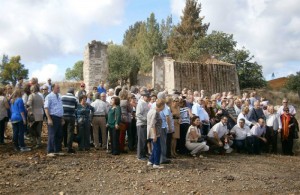On October 20, more than 190 people gathered at the site of the lost village of La Naya, situated in Huelva, Southwest Spain, in order to remember the time that they lived, there during their childhood. Most of them were neighbors and they travelled from Madrid, Barcelona, Seville and Bilbao to assemble here.

A meeting in La Naya, demolished
The Naya was a mining village of Rio Tinto. It was demolished in 1973.
If I can relate a short review of the history the village to you.
In 1873, the Spanish government sold the Minas Rio Tinto to a consortium of foreign capital, that once constituted, in London, would form the Rio Tinto Company Limited (RTCL), which exploded Rio Tinto until 1954. It was the rail-road required to transport ore and copper, from Rio Tinto to Huelva.The territory, that would occupy Naya, served as a supply and logistics for rail operators and, by 1876, already had homes and a canteen-store, linked to the Warehouse number 2, for the release of food and basic necessities, for employees the company residing there and rail-road workers.
In 1882, twenty-eight houses, four of them for foremen, were built. Later, between 1908 and 1909, a further fifty houses were built. The workers' dwellings were arranged in rows, precisely eight parallel and three perpendicular to the above. They were arranged on one level, each had three or four bedrooms and an average area of 45 square meters built.
The main occupation of the inhabitants of La Naya was the classification and organization of rail convoys, until after the end of the eighties of the nineteenth century was the treatment and processing of mineral, with the installation of mineral processing plants, as Washers and later with the construction of Copper Smelter in 1903 and the Concentrator, to which must be added that, from 1912, the construction of the tunnel No. 16, where Naya determined that all ore from South Reef, North and Masa San Dionisio (Corta Atalaya) was processed in the area Zarandas-Naya. This meant that, from the beginning of the Twenty Century, The Naya growed again to host the operators assigned to the zone to the treatment of mineral (Foundry, Concentrator, Washers, crusher plant, plant Ferrous Sulfate, etc.).
The Naya included: a chapel, a school with two rooms for boys and girls and a playground, the mining Casino, a Guardia Civil headquarters and commodities were acquired in Warehouse Company.
It also provided public laundry, because not all houses had running water, for this purpose one was built fifty meters from the village near the station, where it took the water.
The end of Naya was linked to the interests of the mining company and it is mainly due to two factors. The first is that many of their neighbors, employed in the foundry and factory acid, were taken, between 1969 and 1970, along with the facilities to Huelva, where they were assigned homes in the neighborhood of "Patiño". The second factor is that the rules of the early seventies required the "Company" to install a modern sewage and drinking water grid, so it was cheaper and useful for it to relocate the inhabitants of Naya in the current village of Minas de Rio Tinto, in the new homes in Los Cantos or in the Alto de la Mesa. This also managed to concentrate the population near the new work centre, located in Cerro Colorado. Once evicted Naya, in 1972-1973, it was demolished in 1973.
Now, I would like to show you a video with scenes from La Naya. Please click on the link below:
http://www.youtube.com/watch?v=b2zoBxEeKYE
Those attending the meeting had a meal at a restaurant in Rio Tinto. They were recalling memories and anecdotes of the past. At the end of the meal, recognition was given in memory of two priests: Manolo Vargas and Antonio Martin Bueno; also two teachers: Fernando Espinosa and Manuel Garcia Carmona. The latter already deceased, but his children attended from Barcelona to honour the recognition.
Well, I think this reunion has been a great success and would love to see The Naya restored.
Until my next post, kind regards,
Luis.
Sponsored by Costaluz Lawyer.
Please click below:
